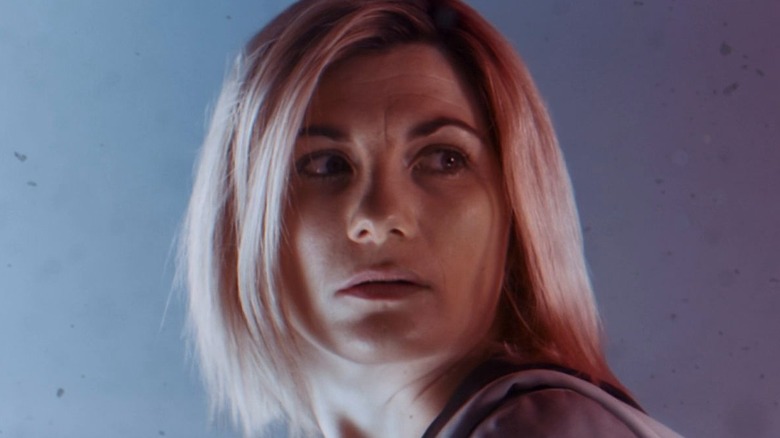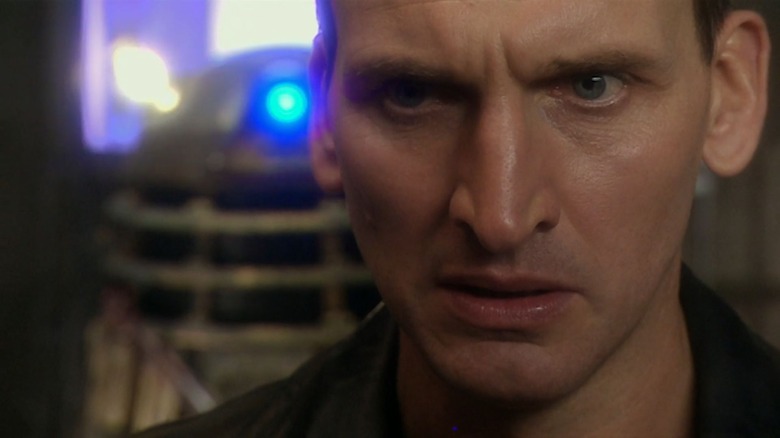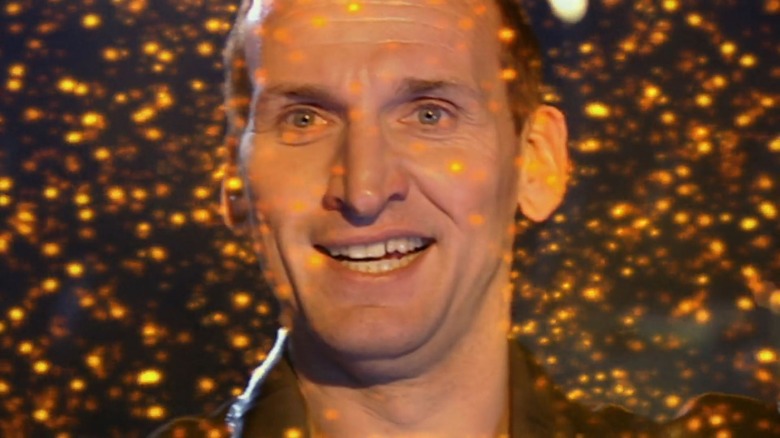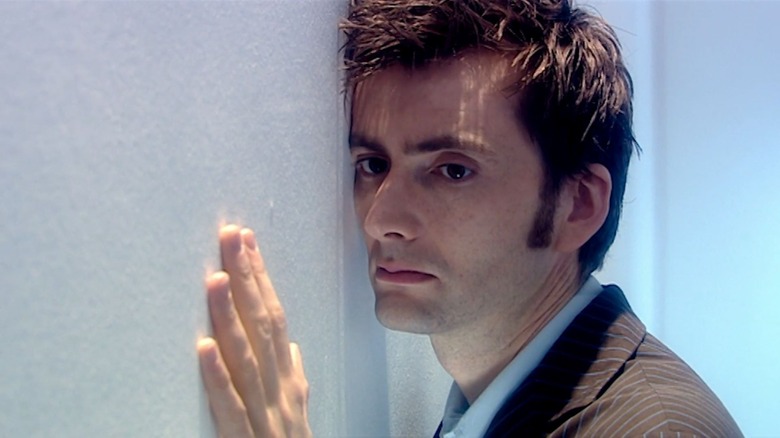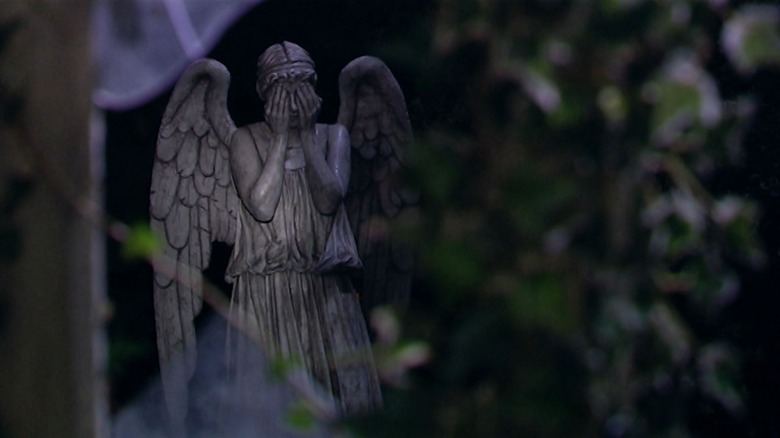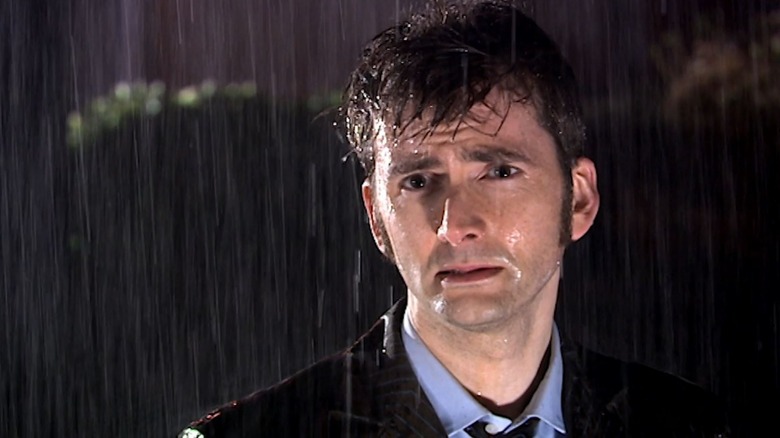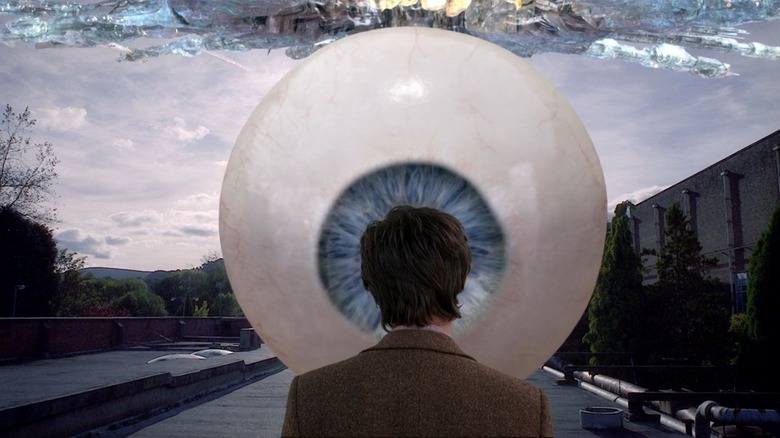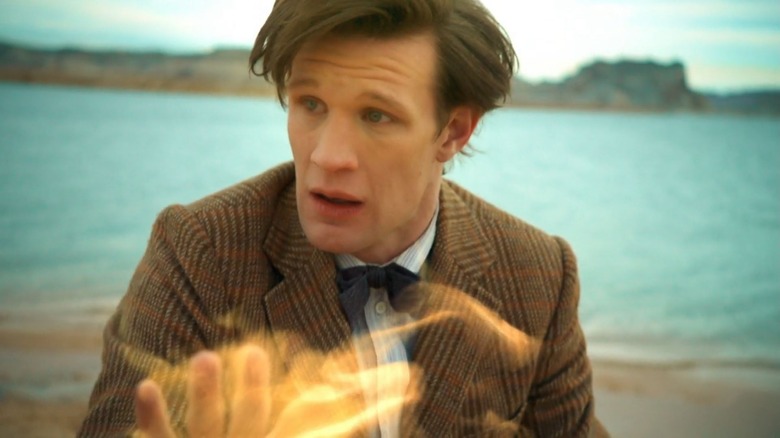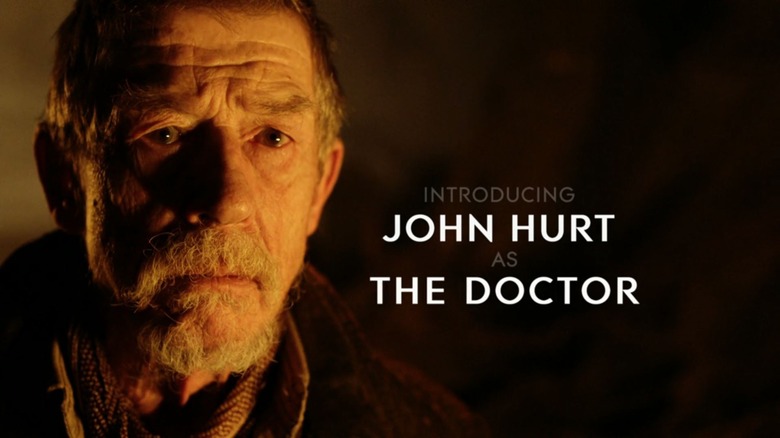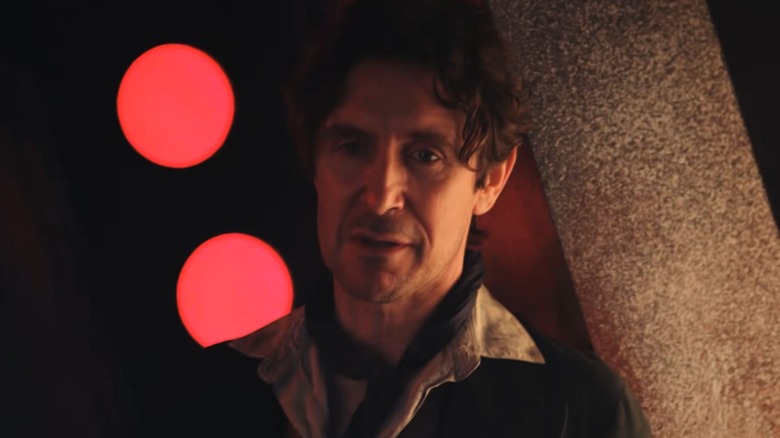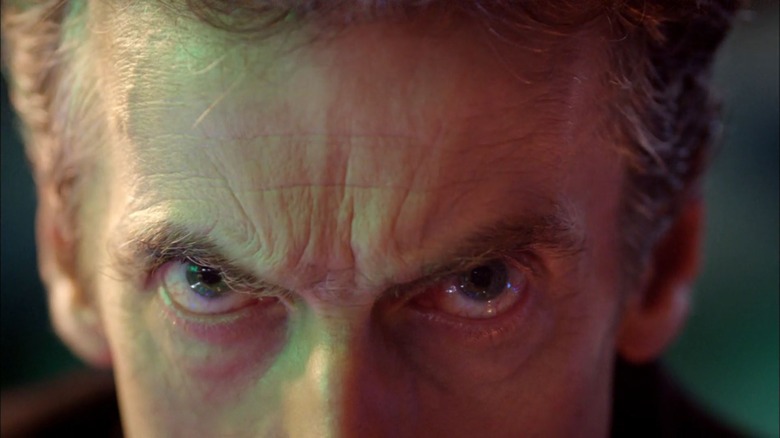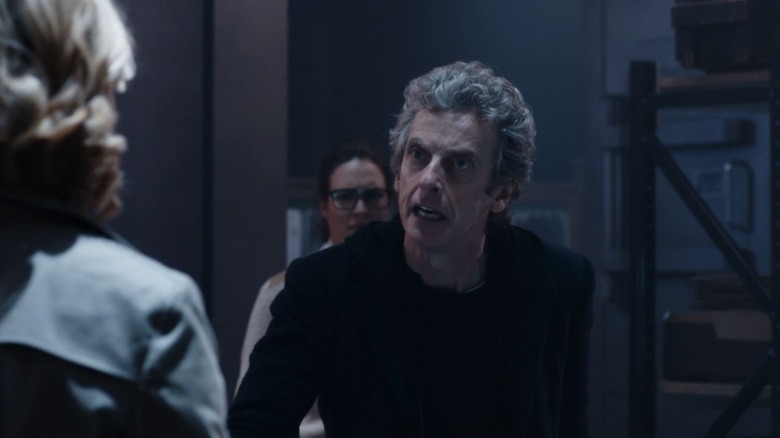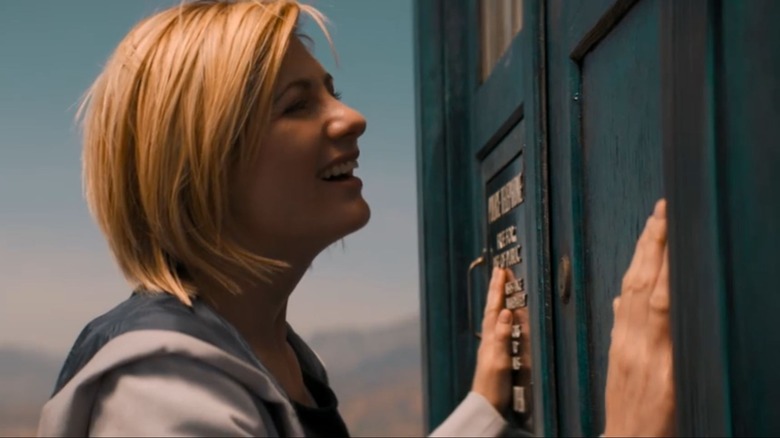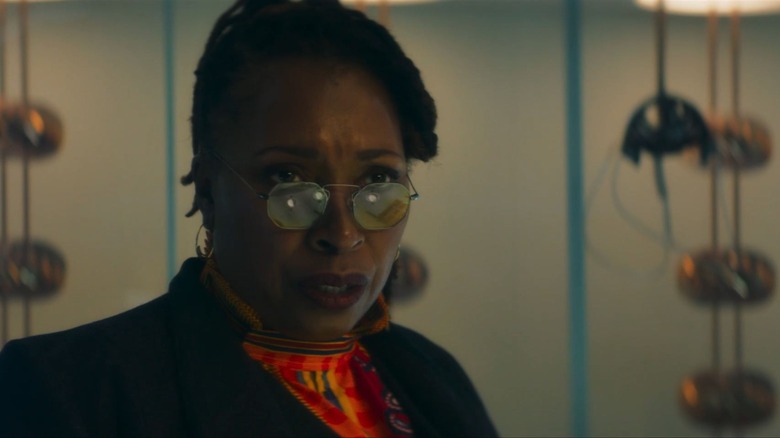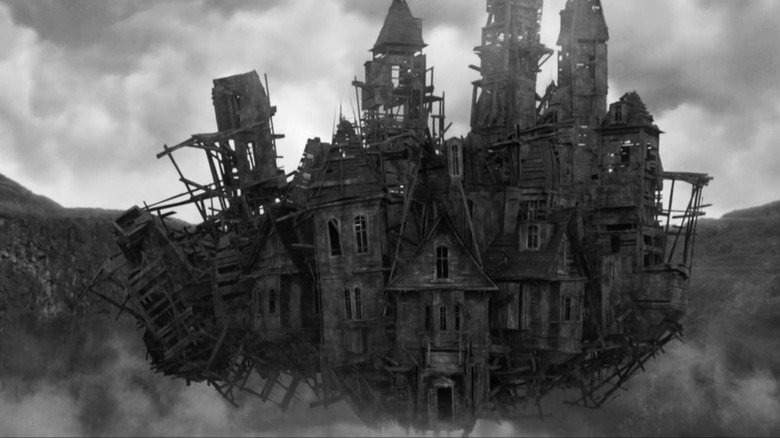The Most Paused Moments In Doctor Who
For a show that's been on the air as long as "Doctor Who," any list of highlights is an overwhelming number of options to choose from. The program has aired around 40 seasons since it first premiered in 1963, and even restricting such a list to the revived series would only limit a survey down to almost two decades of television instead of six.
With over 13 seasons and about as many original Doctors as the classic series, "nuWho," as it was initially called, isn't so new anymore. It has built its success off the backs of scene after incredible scene that have gone on to live rent-free in the hearts and minds of its fans for nearly a generation. Even with that vast expanse of choice, every Doctor has had a few moments that have managed to stand out, and those are the moments that are destined to be the most paused in "Doctor Who."
The Ninth Doctor meets the last Dalek
For many older fans, 2005's "Dalek" episode cemented the new show as proper "Doctor Who" and fully established Christopher Eccleston as "The Doctor." In writing this story, Robert Shearman managed to do the impossible and actually made the Daleks scary again, and no scene better illustrated that achievement than the new Doctor's first encounter with his oldest foe.
Believing he was responding to an innocent distress call, the Doctor confidently enters a darkened cell ready to help whoever's inside, but the second he announces himself, the twin lights and eye stock illuminate, and the static, robotic voice calls out of the darkness. The Doctor immediately knows what the creature is, and he is terrified. This is the first time in the series that viewers see this kind of reaction from the Time Lord, and it sells the threat perfectly.
As he realizes that the Dalek is unarmed, the Doctor relaxes slightly, but his discussion with the monster reveals just how damaged he really is. This version of the time-travelling hero is fresh out of the Time War, a devastating conflict that nearly destroyed all of reality. He had been forced to end it by destroying both the Daleks and his own people, and that cost weighed heavily on his soul. Viewers can see glimpses of that pain in previous episodes, but it's only when he's confronted by the reason for that pain that fans finally see it full-force, and this is that moment.
'Everybody lives!'
The ninth and tenth episodes of Season 1, "The Empty Child" and "The Doctor Dances," were the first two televised stories of "Doctor Who" by future showrunner Steven Moffat, and they remain some of his best work on the show. After spending the first season slowly but surely exposing the Doctor's pain and its consequences, the writers finally gave him a gift.
Arriving in Great Britain's capital during the London Blitz, the Ninth Doctor and Rose find something more dangerous than the bombs: a small child in a gas mask looking for his "mummy" who will make anybody he touches just like him. The kid, and the episode as a whole, are terrifying, but in the end, the Doctor figures out that the issue is being caused by millions of futuristic hospital nanobots — nanobots that can be updated.
And so the Ninth Doctor, fresh out of a war where all he knew was death, gets to save everybody. He fixes the errors that were causing the nanobots to "heal" humans into the gas-mask zombies and sends them forth to return every single person to normal. As he jubilantly tells Rose, "Everybody lives, Rose. Just this once, everybody lives!"
Rose and the Tenth Doctor are separated by Doomsday
While some moments live on, Etch-A-Sketched into fans' memories as joyous triumphs, others are carved into their souls by tragedy. The first and, for some, most painful of these moments was Rose's departure in Season 2, Episode 13, "Doomsday."
The Tenth Doctor, played by David Tennant, had done it. Faced with an army of Cybermen on one hand and an army of Daleks on the other, with humanity caught helplessly in-between, he had managed to banish them all into a dimensional void without damaging the Earth. But as the portal was just about to close, Rose Tyler lost her grip and fell toward it. Though her father managed to save her before she was lost forever, she and the Doctor were forever separated by dimensional walls that could never be breached.
For newcomers who had come to love the show as a grand, science fiction romance, the loss was devastating, and the thought of the alternating shots of Rose and the Doctor both pressed against separate walls might still cause tears to well up to this day. As if more pathos was needed, the shots expertly highlight the differences in their characters as well. Rose screams and pounds on her wall, feeling the sharp stabs of her first major heartbreak while the Doctor leans against his without a tear or a sound, showing that this is just one more crack that he has to carry in his ancient, shattered heart.
The Weeping Angels terrify a nation
To say that "Blink," the tenth episode of the revived show's third series, is beloved would be as great of an understatement as explaining that the Weeping Angels are a tad startling. It remains, to this day, to be one of the most popular episodes in the show's 60+ year-long history (per IMDb), and it is a testament to Steven Moffat's skills as a writer that there exist only a handful of other episodes that might be able to top it.
To pick one moment from this episode is difficult, but the camera's first shots of the weeping angel has to be one of its best. First-time viewers don't know what it is yet, just that it's the only thing that's clearly visible after something threw a rock at Sally's head. On every watch thereafter, fans will know exactly what it is, what it can do, and just how much danger Sally Sparrow is really in. The fact that she's clueless just adds to the tension, making the shot perhaps the most chilling visual in the entire episode.
The famous gif of David Tennant crying in the rain
Even people who've never watched "Doctor Who" have likely seen the gif of David Tennant's Tenth Doctor mourning in the rain. That gif alone might make this the show's most paused moment of all time, but the story that goes with it is just as memorable.
In 2008, the show's two spin-offs, "Torchwood" and "The Sarah Jane Adventures," crossed over in "Doctor Who's" fourth season finale as a celebration of everything the revived series had built up across its first four years. The casts of the three shows united, defeated the Daleks, and saved the universe once again. It was the fan-service moment of the decade, but its joy didn't last for long.
Donna Noble, the Doctor's companion at the time, had accidentally absorbed a portion of Time Lord consciousness that her human body could not contain without dying. To save her life, the Doctor had to seal that consciousness away, and to do that, he had to lock away her memories of all their time together. She would never remember him or their adventures, and this was his last look toward her as he said goodbye to a friend who no longer remembered him. The moment is extremely problematic because it presents a male character completely stripping away a woman's agency without her consent, but it will likely live on for a long, long time, for better and for worse.
'I'm the Doctor. Basically, run!'
It's 2010, and the most popular Doctor of all time has just been replaced with a young actor that nobody has ever heard of, and even though the new showrunner is the same person who wrote "Blink" and "The Empty Child," it's hard to imagine that anybody could possibly live up to everything that's come before. And then "The Eleventh Hour" aired on April 3, 2010.
The first episode of the show's fifth season, this story is perhaps the best introduction to the Doctor, the show, and their universe that has ever been written. In a mere 64 minutes, Mr. Moffatt walked fans through the concept of regeneration, the intricacies of the TARDIS, two brand-new companions, a brand-new monster, and the show's decades-spanning history and legacy to boot. And it does all of that while telling a tightly plotted story that also happens to be a perfect example of what the show is like without relying on crutches like the Sonic Screwdriver or the TARDIS.
But the moment that tops it all off is its finale, where, after driving the alien threat off of Earth, he calls them back to give them a little speech. He tells them to look him up, and they display a hologram that showcases all of the Doctor's lives, and as it finally gets to the Eleventh Doctor, Matt Smith steps through the imagery and delivers his final blow: "Hello, I'm the Doctor. Basically, run!" They do.
The Eleventh Doctor dies at Lake Silencio
It's hard to imagine that anything could top the beginning of "Doctor Who's" fifth season, but showrunner Steven Moffatt sure gave it his best with "The Impossible Astronaut." After only 7 minutes and 31 seconds of the first episode of the show's brand-new season, Moffatt killed off the Doctor. He has an astronaut rise out of Lake Silencio in the middle of the day in United States' own Utah, of all places, and shoot the Doctor dead.
After two hits, he starts to regenerate, but he's struck down a third time before the process can truly begin, and he is dead. They even cremate his corpse just to show that he isn't about to get up and walk away the moment the other characters look away.
To many watching at the time, it was mind-blowing. The show's main character was dead. What were they going to do? A different version of the Doctor was quickly introduced that was several hundred years younger than the one who was killed, and viewers watched for the rest of the season as he marched ever closer and closer to his inevitable death, and that all started here.
'Introducing John Hurt as the Doctor'
The year is 2013. The show's 50th Anniversary is nearly here, and Season 7's finale has come and very nearly gone, but it has one last secret, one final surprise. In a strange, ephemeral peak inside of the Doctor's long, twisted timeline, viewers see a piece that had been hidden from them until now.
With his back to the camera, he spoke. "What I did, I did without choice ... " — his voice is old, gravelly, and unfamiliar — " ... in the name of peace, and sanity." The Eleventh Doctor, the current version, responds: "But not in the name of the Doctor!" As he finishes speaking, the figure slowly turns around, and six words appear on the screen that would set a fandom ablaze with anticipation for a special that was still months away: "Introducing John Hurt as The Doctor."
The show was presenting fans with a new version of the Time Lord that they had never seen before, and though he would become known as "the War Doctor" and even receive his own novel and audio drama series, viewers knew nothing of that at the time. They would wait in agony to find out as that final shot spun 'round and 'round the internet in article after article until then.
'I'm a Doctor ... but probably not the one you're expecting.'
With the 50th Anniversary just over a week away, the BBC released a 6 minute and 48 second short on YouTube titled "Night of the Doctor." With a spaceship and its only occupant crashing toward a planet below, the TARDIS quickly appears to save it, and as the camera switches back to the pilot, a voice rings out behind her. "I'm a Doctor, but probably not the one you're expecting." As he speaks, Paul McGann, the Eighth Doctor himself, steps into view.
The mini-episode serves as a prequel to the anniversary by showing how Paul McGann's version of the Time Lord regenerated into John Hurt's newly revealed incarnation, but it's far more special than that. Though McGann had, for over a decade by that point, starred in dozens upon dozens of full-cast audio dramas, he had only appeared in one televised story before "Night of the Doctor."
It was a 1996 made-for-television movie that was coproduced by both the BBC and Fox networks and released simultaneously in the United States and Great Britain. Though many people enjoyed McGann's new version of the Doctor, the special didn't perform well enough to earn a full series pick up, leaving the show in limbo once again after its cancellation several years earlier in 1989. To see McGann's Doctor again in the flesh on TV was incredible for longtime fans, and seeing him regenerate too was just the cherry on top.
'No, sir, all 13!'
Released on November 23, 2013, the 50th Anniversary was filled to the brim with fan-pleasing moments. It was the new series' first proper multi-Doctor story, it brought back David Tennant's fan-favorite Tenth Doctor, and it finally explained the mystery behind John Hurt's new version of the character. It had Zygons and Daleks, UNIT and Gallifrey and the Time War, and all of it was spectacular. Then the finale hit.
The special's three Doctors figure out a way to save Gallifrey from the final destruction of the war by freezing it within an alternate dimension, and they call in every previous version of the Doctor to do it. Every single Doctor from the show's long history made some sort of appearance through the use of archive footage, and as a despondent Time Lord groans that all 12 Doctors have arrived, his aide quickly corrects him.
"No, sir, all 13!"
And with that, two brief shots gave fans their first, unexpected look at the brand-new Twelfth Doctor, Peter Capaldi, before his first episode had even aired. The BBC had only announced his casting just a few short months before (via BBC News), but there he was, pulling a lever while the camera provided a quick, dramatic shot of Capaldi's eyes. He looked fierce. Fans didn't know what was still to come, but they could not have possibly been any more excited.
The famous speech about war from The Zygon Inversion
The seventh and eighth episodes of "Doctor Who's" ninth season, "The Zygon Invasion" and "The Zygon Inversion," finally followed up on the 50th Anniversary special's Zygon plotline. The shape-shifting alien species had been left on Earth as refugees and given a place to live so that both species would leave the other alone.
That changed when a group of Zygons decided their living conditions weren't good enough and began a reign of terror against humanity and its protectors: UNIT, the "Unified Intelligence Taskforce." UNIT was the Earth's premier defenders against alien incursions whenever the Doctor wasn't around, and they were already at war with the Zygon faction by the time the Doctor arrived.
After careful planning, however, the Twelfth Doctor manages to maneuver both factions into the same room in which they had made the original treaty several seasons prior. He presents the head of UNIT and the leader of the Zygon group with their own box. Each box has two buttons. One button will destroy themselves, and the other will destroy their enemies. They can only select one, however, and if they make the wrong choice, both factions will die.
Then, he convinces them to choose peace instead with one of the show's best speeches. He explains that every war has ended the same way: with talking that could have happened without the bloodshed, and it will leave many viewers needing to pause to reflect on what they've just witnessed.
The Thirteenth Doctor reunites with her TARDIS
The methodology behind Jodie Whittaker's introduction as the Thirteenth Doctor was almost the opposite of Matt Smith's intro in "The Eleventh Hour." Instead of a single, action-packed story that gave new viewers a fast-paced tour of the entire "Doctor Who" universe, Season 11 introduced one aspect of the show at a time.
Its first episode, "The Woman Who Fell to Earth," introduced the new Doctor, regeneration, her sonic screwdriver, and her new companions. It wasn't until the very end of its second episode, "The Ghost Monument," that it finally brought fans the TARDIS.
Stranded first in the vacuum of space and then on a desert planet in the middle of a small warzone, the Thirteenth Doctor is desperately trying to track down her beloved TARDIS. It's more than just her time machine. It's her home and the oldest friend that she has. At the very end of the story, she finally finds it, fading in and out of existence as it struggles to hone in on tangible coordinates.
After a few tense moments, the Doctor finally stabilizes the TARDIS and basically gives it a hug. It's a wonderful, tenderhearted moment between the show's two oldest characters, and the joy on Jodie Whittaker's face is evident to all.
The secret hidden behind 'Ruth Clayton'
In Season 12's fifth episode, halfway through its run, the show flipped itself on its head. Arriving on Earth once again, the Doctor discovers that the Judoon, a species of alien police rhinos, are hunting for a fugitive, and their prime suspect is a woman named Ruth Clayton who seems to be as normal as humanly possible. The Doctor helps her escape and takes her to her childhood home: an old lighthouse on the coast.
Once there, Ruth, played by Jo Martin, hears voices calling out to her from an old fire alarm, and when she breaks it, golden energy swirls about her just as the Doctor discovers a TARDIS, her TARDIS, buried outside. Jo Martin was the Doctor. "Ruth" was just a human form she took on to hide from a group known only as "the Division."
Now that the trickery was revealed, the two Doctors teamed up, sort of, to defeat the newly revealed Doctor's pursuers, but a greater mystery remained: neither Doctor remembered being the other. One of them had to be the older version, but neither could say who that was or why they couldn't remember. While fans waited until the season finale to find out, the moment Martin's Doctor was revealed would have to hold them over.
The haunted mansion at the end of the universe
Collectively titled "Flux," Season 13 of "Doctor Who" was only six episodes long, and it told one, complete story. It was shortened due to the safety precautions that had to be observed due to the COVID-19 pandemic, but it managed to wow its audiences all the same (via RadioTimes). After a strange emanation known only as the "Flux" ripped time and space apart across the universe and nearly destroyed reality as Earth knows it, the Thirteenth Doctor regains consciousness in a mysterious, black-and-white world in its second episode, "War of the Sontarans."
She opens her eyes, and in front of her, floating in midair, is a massively distorted house. To say it looks haunted is an understatement. The image almost delves into uncanny valley territory as the broken towers across its misshapen wooden features distort into the five fingers of an upturned hand. The Doctor reaches toward it, almost subconsciously recreating the same gesture before fully coming to on a battlefield in the middle of the Crimean War in 1855.
Though it was strange, eerie, and chilling, the imagery was excellently executed, set the stage for the rest of the season, and captivated fans imaginations as the season slowly unfolded.
